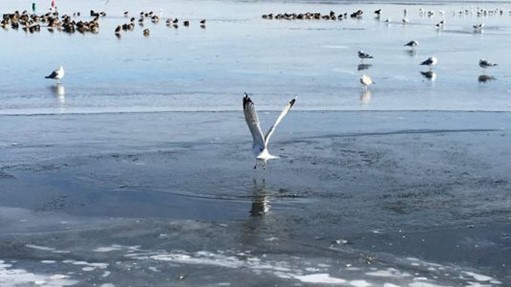A death warrant for the Chesapeake Bay?
Opinion by GERALD WINEGRAD
Saturday marks the 40th anniversary of the signing of the first Chesapeake Bay Agreement. As a Maryland state senator at the time, I witnessed this event along with 700 other hopeful activists. Our optimism for a clean bay is being crushed as the harsh reality sinks in: The Environmental Protection Agency is badly failing in its duty to enforce the Clean Water Act and to prod bay states to meet mandatory pollution reductions to restore the Chesapeake. This is despite the states being given 15 years to comply.

FILE – Birds gather on the frozen waters of the Chesapeake Bay in Havre de Grace in 2018. (MATT BUTTON/THE AEGIS / Baltimore Sun Media Group)
This capitulation occurs after repeated failures to meet pollution reductions first set in 1987. There were no consequences except impaired water quality, flesh-eating human diseases from water contact, and declining fisheries and bay grasses. Once again, the EPA and bay states are punting. Instead of enforcing the Clean Water Act, the EPA and states are taking two years to “recalibrate” pollution limits and the requirements for plans to achieve them. Bay states will miss key targets again to restore basic water quality with impunity.
The recent Sun commentary by Adam Ortiz, U.S. EPA Administrator for the Mid-Atlantic Region, would have readers believe the bay restoration is succeeding after four decades of formal efforts. This distorts reality as the EPA’s abdication of responsibility leaves 72% of the bay’s waters impaired (polluted) under the Clean Water Act. In 1985, 73.5% of waters were impaired.
Such a miniscule improvement comes after 40 years of efforts and billions of dollars spent. The pollution reductions EPA set in 2010 were forced upon the agency under a federal court settlement whereby the bay states were required to have measures in place by 2025 to remove 100% of bay water from impairments. Is achieving 28% a success?
The EPA Inspector General’s July 18, 2023, report castigates EPA’s failed leadership in not steering the states to significantly reduce the largest sources of remaining pollution — nonpoint sources, mostly agricultural pollution, followed by developed lands runoff. The report found that the EPA had data as early as 2018 documenting how off-track bay restoration was, and yet the EPA failed to push the states or impose any meaningful sanctions to gain compliance.
The Bay Program’s Scientific and Technical Advisory Committee (STAC) in their May report reviewed by 50 scientists, refutes Mr. Ortiz’s claims of major phosphorus reductions: “While Chesapeake Bay Program modeling suggests that phosphorus reductions are nearly achieved, analysis of water quality at riverine monitoring stations finds limited evidence of observable reductions in P concentrations.”
These top scientists also found that reductions in nitrogen, phosphorus and sediment were overestimated from BMPs for agriculture and developed lands due to ineffectiveness. They advised that “Additional funding of existing implementation efforts is unlikely to produce the intended nutrient reduction outcomes … the extensive history of nonpoint policy illustrates the limits of relying on voluntary actions…Current research suggests that the estimated effects of Best Management Practices (BMP) have not been linked to water quality improvements in most streams.” This is after $2 billion given to farmers in BMP grants.
Despite these findings, EPA’s proposed solution is to continue to throw hundreds of millions of dollars at farmers for voluntary BMPs. This will not work to achieve necessary water quality improvements.
The smallest dead zone in a generation was recorded in 2023, but this was likely due to severe drought conditions lessening nutrient flows. In 2017, a wet year, the dead zone increased substantially.
Claims are made of a rebound in crab and oyster populations. In reality, 2023 data showed that juvenile crab abundance remains at one of its lowest levels. The Chesapeake Bay Blue Crab Advisory Committee urged precautionary management. Glenn Davis, a Maryland DNR crab biologist, told the Bay Journal the 2023 data was “tot exactly good news. This is still really bad.” Oyster populations remain at less than 2% of historic levels.
Goals committed to by bay states for forested buffers, wetland establishment, and Bay grasses were missed by huge margins. EPA’s Ortiz would have readers believe these were successes.
Two senior bay journalists writing in the December Bay Journal, declared: “Reality has long since set in, along with an understanding that the Bay will never be ‘restored.’” The STAC scientists concluded that: “The fact that water quality conditions have not deteriorated given significant economic and population growth, land use change, and a changing climate in the past three decades is a notable accomplishment.”
So, are we to accept a Chesapeake no better than today’s degraded body of water?
— Gerald Winegrad, Annapolis
The writer served in the Maryland legislature for 16 years, 12 of them as a senator leading efforts to restore Chesapeake Bay as chairperson of the Environment and Chesapeake Bay Subcommittee.
Bonus Exhibits:
Gerald EMAIL to EPA Deputy Administrator Mcabe